Look, I recognize that like half of you visit this blog for the climbing wall or the pergola, but half of the people that visit my home go for this:
The cabin is a blast, no doubt. It was a kick in the pants to build, too. About, oh, I don’t know, maybe a month after we built it I added the separate elevated reading nook. Originally we were going to mount it to an actual log, but finding the right piece and drying it out would have taken longer than I had patience for, so this just kind of happened.
You know the kind of cook that considers recipes to be more like loose suggestions? Ya, when I’m strictly having fun that’s how I build, too.
…Which is to say, I didn’t have a blog when I built this, and I didn’t take notes. But because so many have asked for a tutorial I’m going to walk through the steps for you. Just, you know, bear with me, and ask whatever questions you have.
Here we go!
Materials
12 – 2x4s @ 8′ (*This assumes your ceilings are 8′. If they are over that by any amount you will need six 10′ boards instead)
1 – 4×8 plywood at 1/2″ or 5/8″
1 – 2×4 plywood at 3/4″
3″ thick high density foam, 17″ x 36″
2″ thick high density foam, 17″ x 31 1/2″
1×6 mdf @ 4′
1×12 mdf @ 6′
2 1/2″ kreg screws
3″ screws or bolts
paint
1 1/2″ wood screws
2 yards fabric for foam cover
carpet (optional)
wallpaper (optional)
caulking
Tools
Kreg pocket hole jig
miter saw (or circular saw)
table saw (or circular saw)
jigsaw
paintbrush
drill
level
tape measure
Cut List
2x4s
6 @ 8 feet (customize to ceiling height)
7 @ 45″ (for front and back main frame supports)
6 @ 9″ (for side main frame supports)
4 @ 16″ (for top and bottom joists)
2 @ 35″ (for front frame/doorway)
1/2″ or 5/8′ Plywood
17 1/2″ x 33″ (upper floor)
2 @ 15 3/4 x 35″ (lower side panels)
2 @ 15 3/4 x 18 1/4″ (upper side panels)
14 3/4″ x 38 1/2″ (front panel, right side)
11″ x 38 1/2″ (front panel, left side)
48 1/2″ x 16 1/4″ (lower floor)
MDF, 1×12
2 @ 17″
2 @ 15″
MDF, 1×6
2 @ 9 1/2
2 @ 11 1/4
High Density Foam
3″ thick, 17″ x 36″ (bottom piece)
2″ thick, 17″ x 31 1/2″ (side piece)
An important note you should not skip over reading:
This nook is not made for adults. Oh, it will hold you, alright, but good luck getting back out. You have to take that into account while building. The steps are listed in order, because if you skip a step you may not be able to go back to do the previous step because you will have cut off your access. So if you don’t plan to have your three year old climb up and use power tools to get to a spot you built yourself out of, consider the order of steps to be more a rule than a guideline. Everything else you can do as you like. Send pictures, please.
Oh, one more thing:
This post does contain some affiliate links. Kind of a pathetically small amount of them, actually. You can read about that here if you like.
And now, we build…
Step 1
Okay, I lied, one last note: I painted the entire structure after it was all together. My husband pretty well always notes after I have finished builds that I probably should have painted or stained the pieces first for things that are a bit difficult to do after the fact. If we did it again I might take his advice and paint first. Or not.
The legs are formed out of two 2x4s cut to the height of your ceiling. Our ceiling is 95 1/2″ high, so we were able to use standard 8 footers. If yours is higher you will have to move to a 2×10 or longer. we joined them together with wood glue and long screws. I cannot recommend Spax screws enough for this as they will just make the job so much easier. Make four “L” legs, with the long side facing forward for the front, and toward the wall for the back. You’ll need that long side in the back to attach to the wall.
Step 2
Join the two legs on each side with 9″ braces using pocket hole joinery. I set these so the bottom of the first is at 31 1/2″ and the bottom of the next up is at 70″. The top is level with the top of the legs and will go against the ceiling. These set the height of the first and second floor levels. You may wish to adjust them, or need to if your ceilings are higher. Just remember to adjust everything to the same measurement.
Build two of these, one for the right and one for the left, keeping the long boards parallel.
Step 3
Use the Kreg Jig to join the two sides with 45″ boards, set at the same level as the 9″ boards on the side. Add an extra 45″ 2×4 above that middle one. You’ll see why later.
Another view
That’s it for the basic structure. Mark out where your studs are on the wall, then attach the structure to the wall through the back supports and legs. Does it have to be anchored to the wall? Yep,sure does.
Step 4
Okay, for the rest of this we are going off pictures of the finished build. This is where the order of events starts to really matter.
Cut the side panels out of plywood. We used the extra plywood from our playhouse build, which was 1/2″. That has held up just fine. If you would like to go thicker grab some 5/8″ stuff. The top and bottom panels fo the sides should measure 15 3/4″ w x 35″ h for the bottom panel, and 15 3/4″ w x 18 1/4″ h for the top panel. I had to measure this after it was all built, so double check all of your measurements. Fit the plywood to the inside of the L-shaped legs and nail or screw them in.
(You’re working on the piece under the “READ” letters and the one right above it, for reference.) Do both sides.
Step 5
Cut and attach joists for the top and bottom floors. Our joists measured 16″ long. On the bottom just space them evenly. On the top you’ll need to leave room for the access from the bottom. Ours are spaced with the left side at 13 3/4″ from the left side, and the right at 14 1/2″ from the right side. Our decision process for how much space to leave was as scientific as standing a kid up in there to see if they fit. It’s worked fine, even for kids a few years older that have crawled up there. We attached the joists using pocket holes.
Step 6
Cut the top floor. Ours is 17 1/2″ W x 38″ L. Fit it up there between the joists, and lean it against the back wall. Don’t attach it yet!
My husband wasn’t sure about the small space at first, but I remember loving that old school Hamburglar toy at McDonalds as a kid – the one where you climbed up the middle Space-Needle style and then had to crawl around the perimeter. It was a cool adult-free zone, and we loved it. In retrospect it was also definitely a disgustingly germy place. Ew. But seriously, that’s what inspired this space. And, would you know it, it has been a huge hit with the kids.
Step 7
Cut the decorative piece for the front of the top area. You can do bars or whatever you like. I opted for this tree design because I didn’t want to make it look like a jail, but really, a jail is cool, too.
Okay, don’t hate me, but I don’t have a template for you. The problem being that I cannot get up there to trace what I did. Once everything is built, and especially if you have a bridge in the way like we do, it’s a kids only space. To make the tree I measured the inside of that space, inclusive of the 2×4 frame around that opening. The tree branches extend past where you can see and are glued and nailed from the back. To do that we had to place a step stool inside the structure and stand up between the joists. I sketched a design that would insure no one fell out, and then transferred it to wood and cut it out with the jigsaw.
I’m going to be honest with you here. I was a bit nervous that the branches might not be strong enough. I cut them out of 3/4″ plywood just to be extra sure. It has been over a year, and has had a lot of little arms and legs pushing on it, and it has held up without any problem. I have even seen as many as 5 kids at a time up there. It holds great. (PS, I whitewashed it before attaching it to the frame.)
That extra 45″ 2×4 you added to the main frame is to form a lip for the second floor, and attachment points for the tree or bars or whatever you use up there.
Step 8
If you want wallpaper or paint or whatever on the walls up there you’ll want to do that now. We used this one from Target. Then lay that flooring piece that you leaned against the wall up there down and screw it in place. We added a piece of carpet as well from the main cabin scraps.
The bottom floor measures roughly 16 1/4″ x 49″. Cut that out and screw it down as well.
Step 9
Make the bookshelves/steps. I cut them out of mdf. The bottom shelf is made from 1×12. Cut 2 pieces at 17″ and 2 at 15″. The top and bottom are 17″ and the sides are 15″. You will need to notch around the back 2×4 leg with a jigsaw.
The top box is made from 1×6. Cut 2 pieces at 9 1/2″ and 2 at 11 1/4″. The top and bottom are 11 1/4″ and the sides are 9 1/2″. Nail everything together.
I wanted padding at the bottom to make a comfy reading place, so I added some scrap 2×4 pieces under where the shelf would be to elevate it 3″. Place the boxes on top of the 2×4’s, nail everything down and to the frame, then caulk it all to make it nice and seamless.
Step 10
Build the front. The left side panel on ours is 11″ w x 38 1/2″ h. The right panel is wider at 14 3/4″ w x 38 1/2″ h. We framed ours out with 1×2 pieces leftover from the cabin build.
Step 11
Add padding. I’ll tell you a secret. The fabric on ours is not sewn on. It’s safety pinned in the back. You will need to notch the 2″ piece that goes against the wall to fit around the 2×4 in the back. Just cut it with scissors. I got the material from Joann Fabrics, and cannot find it there now. Maybe check your local store to see if they have it in stock.
Step 12
Paint it all, or just touch it up if you painted the pieces, first. I created a custom stain/paint mix to mimic the finish Restoration Hardware put on their version of the cabin (theirs is a bed rather than a playhouse). I shared how to make that mix in my original post here.
Step 13
Add a way up to reading nook. If you are building a cabin playhouse you may want to make a rope bridge like we did here.
Of course you can also include a ladder to the nook, like we did with the main cabin.
There you have it, one elevated reading nook to go along with our cabin themed playroom. It has been over a year since we built all of this, and I am happy to say that my kids (and all of their friends) still love this space. Before someone carries on about how our kids must be totally spoiled I will point out that building all of this cost us less than furnishing the room with couches and whatnot. Also, my living room downstairs stays fairly clean. That alone is worth it, people.
↓Pin it so you don’t forget it!↓



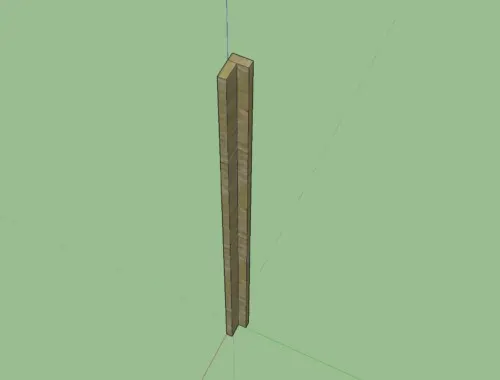
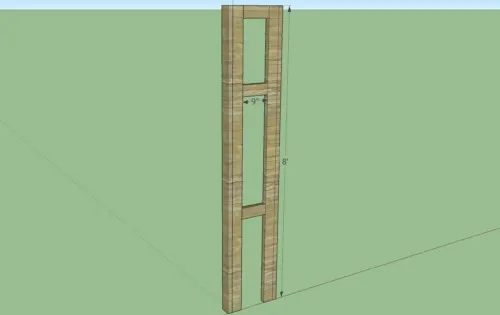
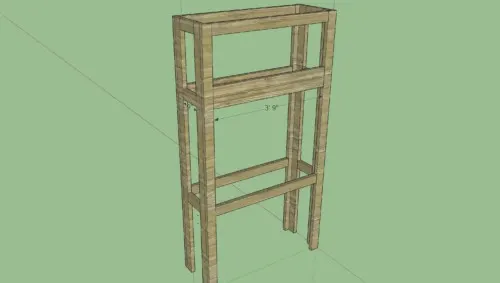
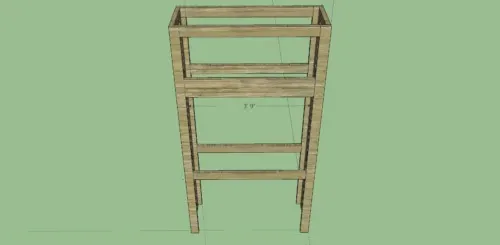

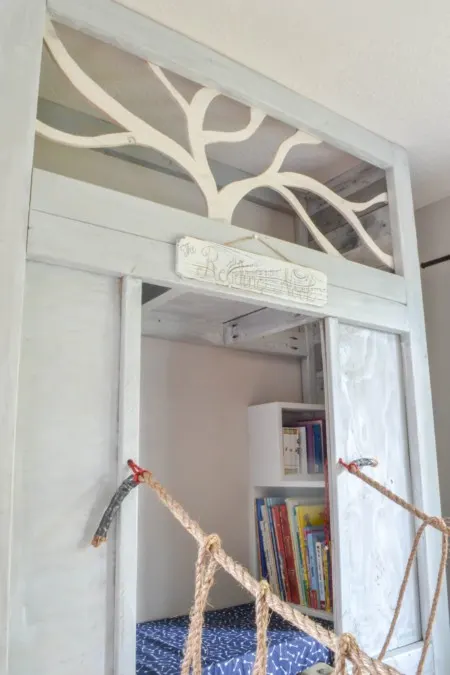
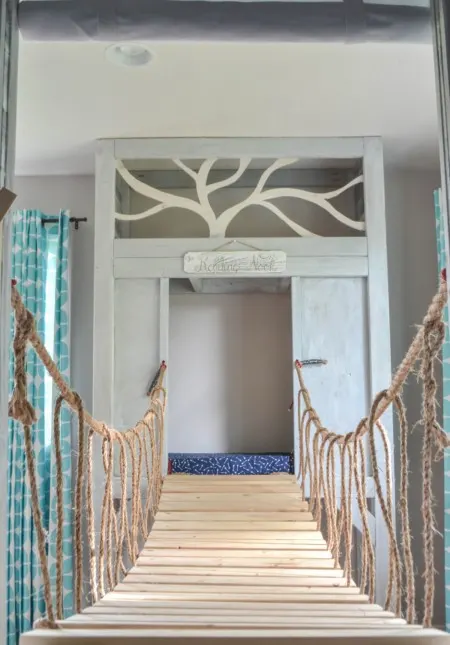
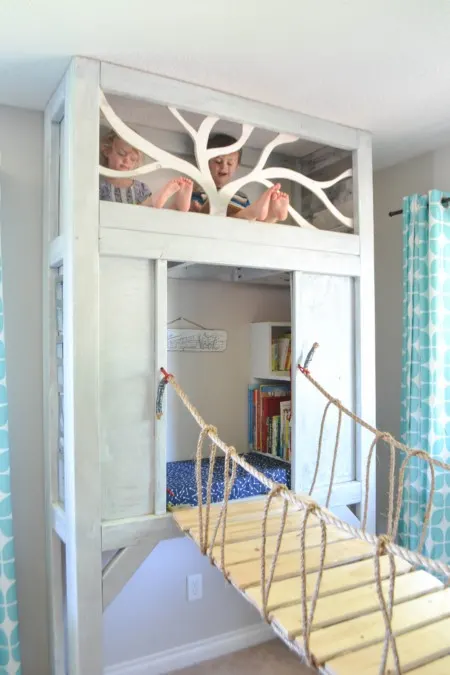
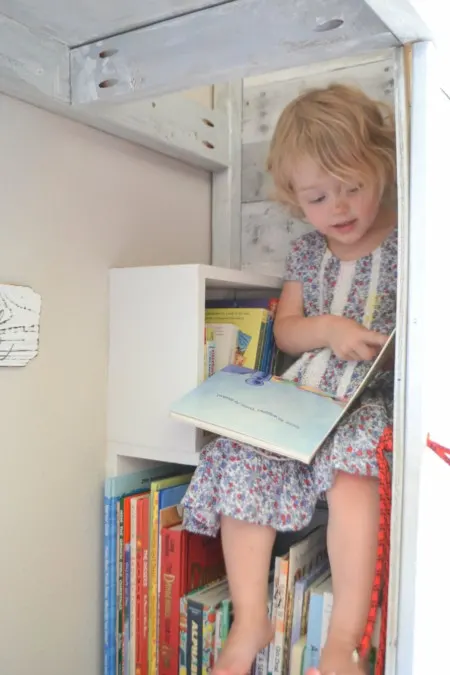
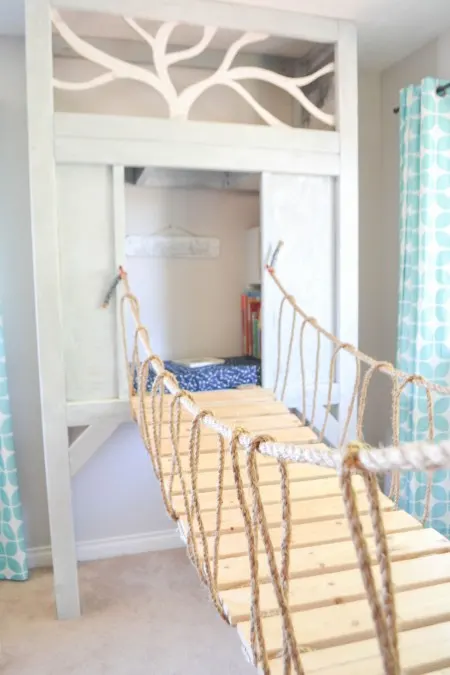
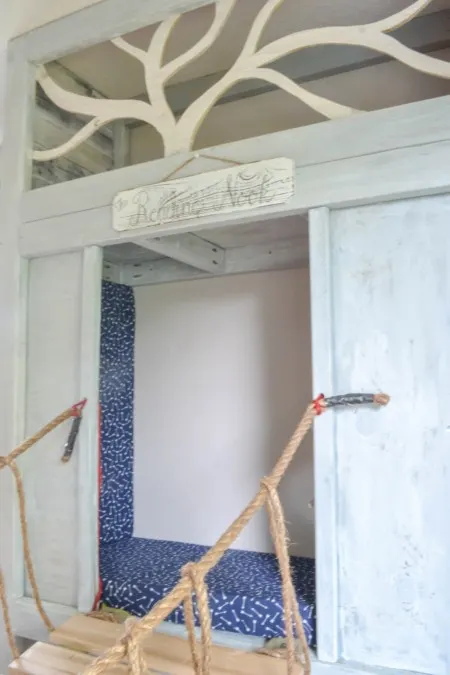
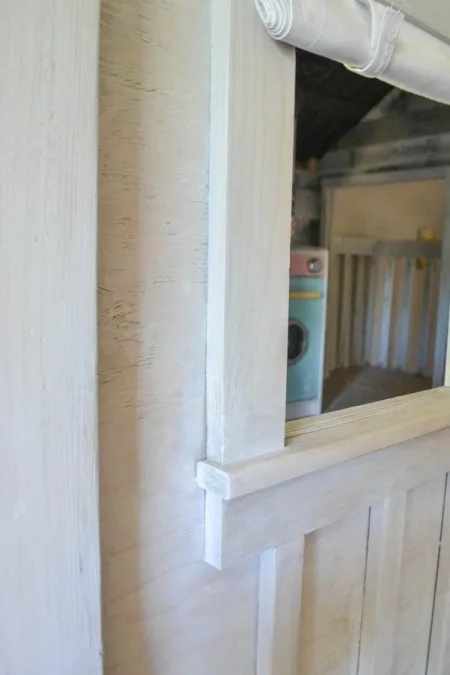
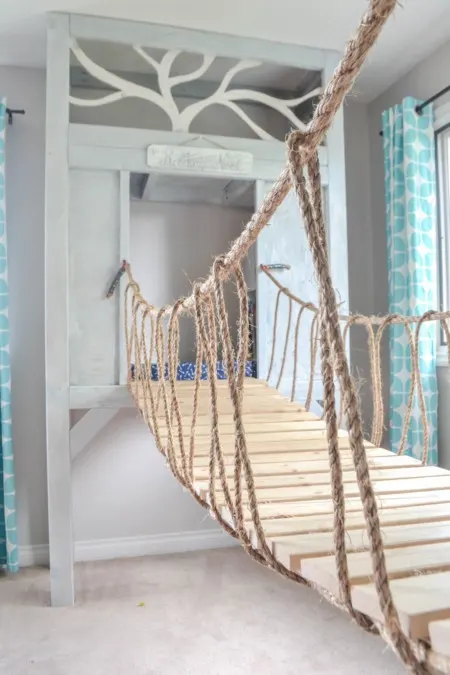
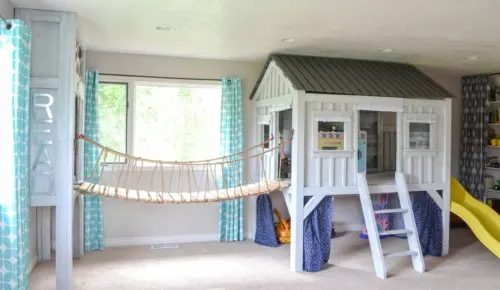

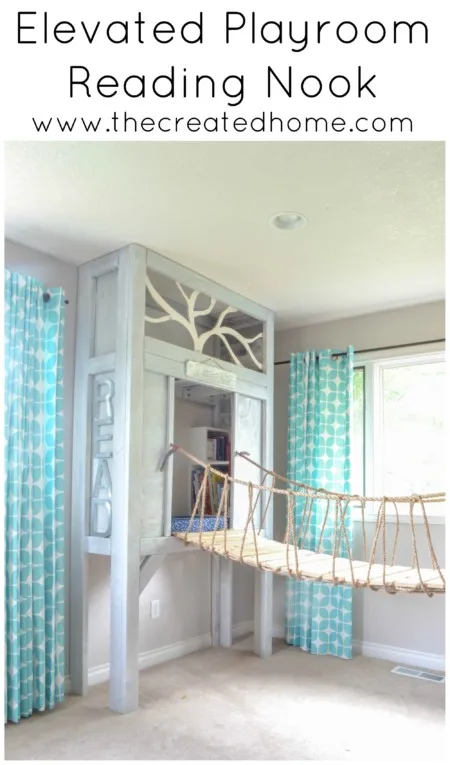
Galna barnrum - Viivilla SE
Wednesday 17th of March 2021
[…] Källa […]
5 kids bedroom ideas to inspire their imaginations
Monday 4th of January 2021
[…] everything else in the bedroom. Why not give them a really special space for their books, from an elevated reading nook, to a really gorgeously decorated bookcase area. Whatever you decide to do; make it special as the […]
How to build a custom kids' closet - The Created Home
Sunday 16th of February 2020
[…] […]
Top 10 Projects of 2017 (And a reader poll) - The Created Home
Sunday 16th of February 2020
[…] The Elevated Playroom Reading Nook […]
Elevated Playroom Reading Nook - The Created Home | Dadne
Friday 31st of January 2020
[…] Original Source […]